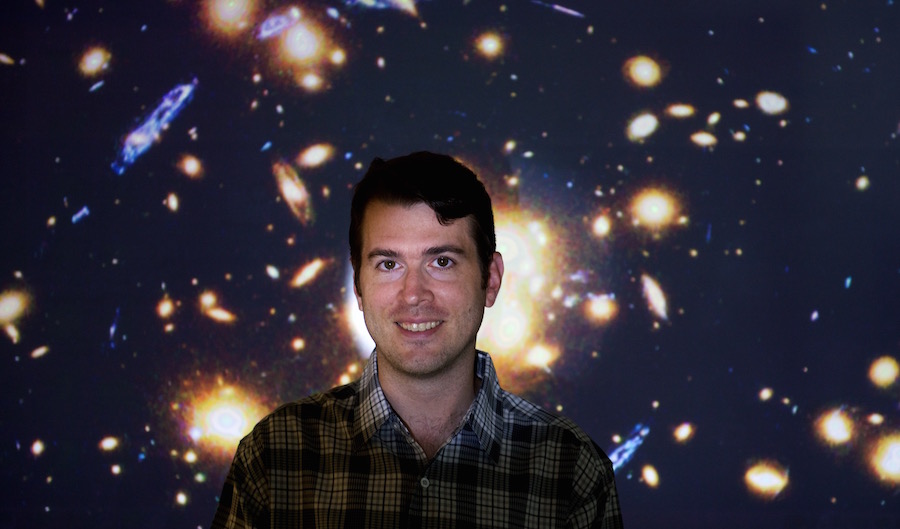
“If there were no dark matter, life wouldn’t exist,” says BMCC Professor of Science and astrophysicist Quinn Minor. He just received a National Science Foundation (NSF) award of $235,407 to study cold, or slow-moving dark matter, and explains its role in our existence.
Early stars “spit out heavier elements like silicon and iron through supernovas,” Minor says, “and they spewed them out so fast, if the extra gravitational pull of dark matter hadn’t been around to keep it all from escaping into intergalactic space, our earth would never have been formed.”
BMCC students can now join Professor Minor in his quest to understand dark matter, through his research project, “Testing the Cold Dark Matter Model by Constraining Dark Matter Substructure in Gravitational Lens Galaxies.”
Funded through NSF’s Division of Astronomical Sciences (AST), the project started September 1, 2016 and will continue through August 31, 2019. Two students per year, or six over the course of the grant, will start by attending workshops to acquire scientific computing skills.
“Programming is a big part of research, since it is data based,” says Minor. “The students will learn Python, which is the ‘hot’ programming language right now, and has become very powerful in scientific computing. They’ll also work with Unix, an operating system that is the standard for scientific software.”
As students move forward in a science career or technical field of any kind — engineering, industry, manufacturing, material science — “they’ll find those skills very useful and it makes them very employable,” he says.
In addition to working with data, the students will attend weekly meetings at the American Museum of Natural History with Professor Minor and other CUNY student researchers, to discuss recent papers in astrophysics. They will give a talk on their research at the Physical Sciences Research Experience for Undergraduates (REU) Symposium at the American Museum of Natural History (AMNH) — where Professor Minor is on staff as a Research Associate — and give a poster presentation at an annual meeting of the American Astronomical Society (AAS).
“They’ll get familiar with scientific jargon,” says Minor, “and it’s important that they see themselves in a research environment. It’s a confidence builder. If they do stay in the field, they’ll be more conversant with other students, and ultimately with other scientists as well.”
All of these activities will provide a meaningful context, as students analyze digital simulations of gravitational lenses, which occur when the light of one galaxy is “bent” by the gravitational pull of another galaxy, which acts as a “lens.”
“We want to be ready,” says Professor Minor, for viewing images now being released by the Atacama Large Millimeter/submillimeter Array (ALMA) in northern Chile.
“ALMA is actually an array of radio dishes,” he says. “Astronomers across all fields use it. It’s come online recently and it’s getting spectacularly high-resolution images of gravitational lenses. Students are working with simulations of the images, so they have an idea of what we can learn from the high-resolution images themselves.”
“Dark matter is an important component of the universe, yet we don’t know what it is,” said Joseph Pesce, program director in the National Science Foundation Division of Astronomical Sciences, which funds this research. “Professor Minor’s project promises to help identify dark matter particles and our understanding of the underlying laws of physics, all while providing research opportunities for students at BMCC.”
For Minor, a key motivator in applying for the grant was being able to provide stipends to students who participate in the research outside of class time.
“Students at BMCC are often working many hours per week just to support themselves, which prevents them from having time to take part in mentored research,” he says. “This way, they not only join the project, they tend to continue their science studies beyond BMCC. A lot of studies have shown that mentored research at an early stage correlates with retention in that field.”
Related articles: BMCC One of 15 Colleges Nationwide to Win $1 Million NSF Grant from STEM Education, BMCC Receives Grant to Create Cybersecurity Concentration
STORY HIGHLIGHTS
- BMCC Professor of Science Quinn Minor receives National Science Foundation (NSF) award of $235,407 to study dark matter
- Funded through NSF’s Division of Astronomical Sciences (AST), the project runs September 1, 2016 through August 31, 2019
- Six students will receive stipends to examine computer data, present papers and more

